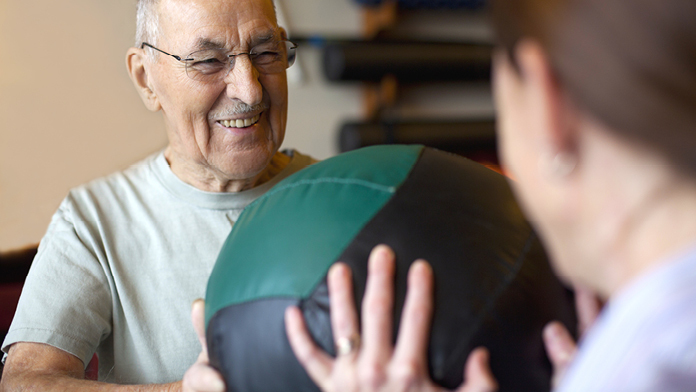The information you will be accessing is provided by another organization or vendor. If you do not intend to leave our site, close this message.
D-SNP home page > Health tips & tools > Walk safer and smarter outside
Walk safer and smarter outside
Your walks should be all about the benefits, not worrying about sneaky tripping hazards, overheating or worse. Use these smart tips to stay safe while you walk your way to wellness.
 By Stacey Colino
By Stacey Colino

If the warmer weather and sunny skies are inspiring you to head outside for a walk, that’s great. Walking has been called the most underrated form of exercise. That’s because many people don’t know it can do so much more than improve fitness and heart health. Walking can help boost mood and energy. It can also ease pain and lower your risk for cancer and chronic diseases.1
“Walking is the best form of exercise — it’s what your body was designed to do,” says Pete McCall, M.S. He’s an adjunct professor of exercise and nutrition sciences at San Diego State University. And he’s the host of the All About Fitness podcast. Walking outside also gives you the added perks of fresh air and natural light.
Still, walking is not risk-free. It can raise your chance of falling, for starters. Most injuries from falls are minor, such as cuts, scrapes and bruises. But 1 out of 5 falls cause more serious injuries, such as broken bones or head injuries.2 Add in summer heat, and you need to think about overheating or becoming dehydrated too.1
The good news: You can stay safe while you stride with a little planning. Check out these tips before you step out, and then put them to good use.
Choose appropriate shoes
It’s up to you what type of shoes you pick. Walking shoes, running shoes or trainers are all great options. Are you walking on an uneven surface, such as a trail in the woods? If so, think about wearing high-top trail shoes or hiking boots. They can help support your ankles.
Whatever shoes you choose, just make sure they check these boxes:
- Comfortable
- Fit well
- Good support on the sides and in the heel
- Good grip in the sole to keep from slipping
- Plenty of cushioning to reduce the impact on your joints
Wear summer-friendly clothes
Put on comfortable clothes in breathable fabrics that “wick” or pull moisture away from the skin, says Fabio Comana. He’s an exercise physiologist with the National Academy of Sports Medicine. This will help remove heat, through sweat, from your body. Some workout clothes also have sunblock built into the fabric. That offers your skin some protection from UV rays, but it’s still important to use sunscreen on areas your clothing doesn’t cover.
Pick the right pace
Start with a pace that feels comfortable. Aim to walk a mile or for 20 minutes at that pace, even if you need to take breaks. (If that’s too challenging right now or if you don’t have 20 minutes, that’s okay — do what you can.) Then, safely ramp up the challenge over time. You can do that by increasing how fast or how long you walk by 10 percent per week. For example, you might walk 20 minutes at a time the first week. In that case, bump up your walks to 22 minutes the next week. It helps to use a fitness tracker or an app on your phone to track your pace, McCall says.
Stay away from tripping hazards
One of the biggest tripping hazards is not paying attention to what’s on the path in front of you. It’s easy to focus more on talking to a friend or listening to music, McCall warns. To be safe, always keep your eyes on the ground 3 to 4 yards (9 to 12 feet) ahead of you. Watch out for cracks in the pavement, rocks and sticks on the road or moisture or moss on trails. “Parks, sidewalks and marked trails are a safer choice than forging your own path,” says Comana.
Stay hydrated
Drink at least 8 ounces of water before you head out. And drink an extra 8 ounces when you come back, McCall advises. This should be enough if you’re walking for less than 30 minutes. If it’s very hot and humid or if you’re walking for 40 minutes or longer, bring a water bottle and sip as you go. Planning to walk for 60 minutes or longer? Mix a sports drink into your water. That will help replace electrolytes (key minerals like sodium and potassium) that get lost through sweat.
Be aware of medication side effects
Different medications can affect your walking in various ways, says Patrick J. Maloney, M.D. He’s a board-certified orthopedic surgeon at Mercy Medical Center in Baltimore. Some examples:
- Beta blockers, often used for high blood pressure. They can reduce the usual rise in heart rate that comes with exercise. That means that if you have a target heart rate during exercise, you might not hit it. (Target heart rate is the number of beats per minute that tells you you’re exercising hard enough to get heart benefits.) A better way to judge may be watching your level of effort, breathlessness and fatigue.3 In other words, if you can’t speak while you exercise, you’re probably working too hard.
- ACE inhibitors, also used for high blood pressure. They can lower blood pressure and lead to dizziness while exercising.
- Certain diuretics and other blood pressure medications can raise the risk of dehydration.4,5
- Some medications can increase sun sensitivity. In other words, they cause sunburn-like symptoms or a rash. Common ones include antibiotics, antihistamines, statins, oral contraceptives and skin medications.6
“Speak to your primary care provider before beginning any new exercise routine,” says Dr. Maloney. When you do, ask about how your medications might affect your hydration levels, sun sensitivity, response to exercise and balance.
1Mayo Clinic. Walking: trim your waistline, improve your health. May 19, 2021. Accessed June 9, 2022.
2Centers for Disease Control and Prevention. Important facts about falls. February 10, 2017. Accessed June 13, 2022.
3Sheps SG. Mayo Clinic. Beta blockers: How do they affect exercise? February 12, 2020. Accessed June 13, 2022.
4Dalleck LC. American Council on Exercise. How common medications may affect your clients’ exercise programs. June 2013. Accessed June 13, 2022.
5Mayo Clinic. Dehydration. September 19, 2019. Accessed June 9, 2022.
6U.S. Food & Drug Administration. The sun and your medicine. September 25, 2015. Accessed June 9, 2022.



